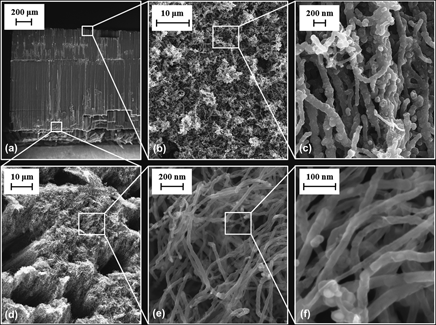Crossref Citations
This article has been cited by the following publications. This list is generated based on data provided by
Crossref.
Bai, Fan
Wu, Juntao
Gong, Guangming
and
Guo, Lin
2014.
Biomimetic “Water Strider Leg” with Highly Refined Nanogroove Structure and Remarkable Water-Repellent Performance.
ACS Applied Materials & Interfaces,
Vol. 6,
Issue. 18,
p.
16237.
Yan, Jihong
Wang, Tao
Zhang, Xinbin
and
Zhao, Jie
2014.
Structural design and dynamic analysis of biologically inspired water-jumping robot.
p.
1295.
Yan, J H
Zhang, X B
Zhao, J
Liu, G F
Cai, H G
and
Pan, Q M
2015.
A miniature surface tension-driven robot using spatially elliptical moving legs to mimic a water strider’s locomotion.
Bioinspiration & Biomimetics,
Vol. 10,
Issue. 4,
p.
046016.
Zhang, Xinbin
Yan, Jihong
Zhao, Jie
Gangfeng Liu
Hegao Cai
and
Pan, Qinmin
2015.
A miniature surface tension-driven robot mimicking the water-surface locomotion of water strider.
p.
3172.
Wang, Haibin
Chen, Eryu
Jia, Xianbu
Liang, Lijun
and
Wang, Qi
2015.
Superhydrophobic coatings fabricated with polytetrafluoroethylene and SiO2 nanoparticles by spraying process on carbon steel surfaces.
Applied Surface Science,
Vol. 349,
Issue. ,
p.
724.
Zhao, Jieliang
Su, Zhengliang
and
Yan, Shaoze
2015.
Thermodynamic analysis on an anisotropically superhydrophobic surface with a hierarchical structure.
Applied Surface Science,
Vol. 357,
Issue. ,
p.
1625.
Golovin, Kevin B.
Gose, James W.
Perlin, Marc
Ceccio, Steven L.
and
Tuteja, Anish
2016.
Bioinspired surfaces for turbulent drag reduction.
Philosophical Transactions of the Royal Society A: Mathematical, Physical and Engineering Sciences,
Vol. 374,
Issue. 2073,
p.
20160189.
Lv, Dandan
Shao, Hongfei
Gao, Xiang
Lu, Ke
Lu, Haifeng
and
Ma, Houyi
2016.
Fabrication and corrosion resistance properties of super-hydrophobic coatings on iron and steel substrates by creating micro-/nano-structures and modifying rough surfaces.
RSC Advances,
Vol. 6,
Issue. 96,
p.
93419.
2017.
Bioinspired Superhydrophobic Surfaces.
p.
111.
Satapathy, M.
Varshney, P.
Nanda, D.
Mohapatra, S.S.
Behera, A.
and
Kumar, A.
2018.
Fabrication of durable porous and non-porous superhydrophobic LLDPE/SiO 2 nanoparticles coatings with excellent self-cleaning property.
Surface and Coatings Technology,
Vol. 341,
Issue. ,
p.
31.
Czyzyk, S.
Dotan, A.
Dodiuk, H.
and
Kenig, S.
2018.
Progress in Adhesion and Adhesives.
p.
307.
Saji, Viswanathan S.
2021.
Carbon nanostructure-based superhydrophobic surfaces and coatings.
Nanotechnology Reviews,
Vol. 10,
Issue. 1,
p.
518.
Zhan, Yanlong
Yu, Sirong
Amirfazli, Alidad
Siddiqui, Abdul Rahim
and
Li, Wen
2021.
Preparations of versatile polytetrafluoroethylene superhydrophobic surfaces using the femtosecond laser technology.
Colloids and Surfaces A: Physicochemical and Engineering Aspects,
Vol. 629,
Issue. ,
p.
127441.
Qu, Mengnan
Liu, Lulu
Yang, Xin
Yang, Chen
Li, Jiehui
Liu, Qian
Peng, Lei
Liu, Xiangrong
and
He, Jinmei
2021.
A Fluoride‐Free and Super‐Wetting Functionalized‐Material with pH‐Responsiveness for Controllable Separation of Multiphase Oil/Water Mixtures.
Advanced Engineering Materials,
Vol. 23,
Issue. 2,
dos Santos da Silva, Alan
and
dos Santos, João Henrique Zimnoch
2021.
Materials with Extreme Wetting Properties.
p.
117.
Nie, Shijin
Tan, Xinyu
Li, Xinyi
Wei, Ke
Xiao, Ting
Jiang, Lihua
Geng, Jialing
Liu, Yuan
Hu, Weiwei
and
Chen, Xiaobo
2022.
Facile and environmentally-friendly fabrication of robust composite film with superhydrophobicity and radiative cooling property.
Composites Science and Technology,
Vol. 230,
Issue. ,
p.
109750.
Wu, Yinglin
Tan, Xinyu
Wang, Yunkuan
Tao, Fujun
Yu, Meiling
and
Chen, Xiaobo
2022.
Nonfluorinated, transparent, and antireflective hydrophobic coating with self-cleaning function.
Colloids and Surfaces A: Physicochemical and Engineering Aspects,
Vol. 634,
Issue. ,
p.
127919.
Zhao, Jing
Sun, Ruoyu
Liu, Chuang
and
Mo, Jiliang
2022.
Application of ZnO/epoxy resin superhydrophobic coating for buoyancy enhancement and drag reduction.
Colloids and Surfaces A: Physicochemical and Engineering Aspects,
Vol. 651,
Issue. ,
p.
129714.
Yu, Meiling
Li, Xu
Tan, Xinyu
and
Chen, Xiaobo
2023.
Fluorine-free preparation of a superhydrophobic coating with anti-icing properties, mechanical durability and self-cleaning effect.
Soft Matter,
Vol. 19,
Issue. 4,
p.
766.
Li, Xinlin
Zhan, Bin
Wang, Xueting
Liu, Yan
Liu, Yanju
and
Leng, Jinsong
2024.
Preparation of superhydrophobic shape memory composites with uniform wettability and morphing performance.
Composites Science and Technology,
Vol. 247,
Issue. ,
p.
110398.



